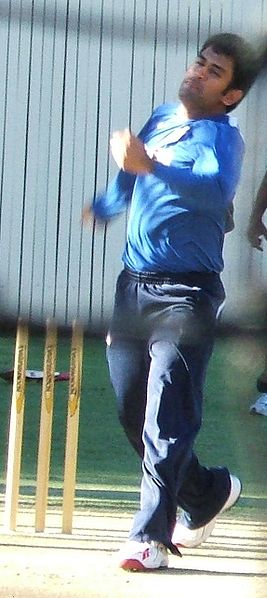The gloves are off ………. he’s having a bowl!
David Taylor |
For sheer reasons of impracticality, the wicket-keeper is usually the least likely member of the fielding side to take a turn at the bowling crease. The time wasted while discarding gloves and pads, not to mention the need for an able substitute to take his place behind the stumps, means that it’s likely to occur only as a gesture of entertainment at the end of a drawn match, or maybe out of sheer desperation on the part of the fielding captain. And yet over the last century or so there have been a number of instances of stumpers turned bowlers, sometimes with a surprising degree of success. At the very lowest level of cricket imaginable, I played for my village 2nd XI under a captain who would often open the bowling with five or six overs at fiery pace, before donning the gloves and pads for the remainder of the innings, and there must have been many frustrated stumpers who, keeping to a succession of inept bowlers, thought “I could do better than this.”
Not every wicket-keeper is able, or has the inclination to bowl of course – Matt Prior has made over 500 professional appearances without once turning his arm over, even though several of those have been as a specialist batsman – but a few have dallied with the idea. In his book My Country’s Keeper Wally Grout related that Don Tallon had the idea, in 1949, of making himself available only as a spin bowler for Queensland. The selectors indulged him briefly, but after sending down 27.5 overs for 133 runs and no wickets he admitted defeat. Grout mused “it’s funny how we keepers get the notion we can bowl, probably the result of years of reading a bowler’s arm.”
I’m going to leave aside those all-rounders who were able to keep, such as New Zealand’s John Reid, and start with the most successful keeper-bowler in Tests to date. In the Oval Test of 1884 Australia’s innings had exceeded 500, going well into the second day, and there being no declaration available at that time, both sides were probably keen for the innings to end. The Hon. Alfred Lyttelton, the Middlesex amateur who would later do his political aspirations no harm by marrying into the Balfour family, was the tenth bowler tried by Lord Harris. In fact he’d had a spell on the previous evening without success but this time, bowling underarm and in his pads, he took four wickets in quick succession to finish off the Australians. They were the only wickets he took in first-class cricket.
Fast-forwarding a few decades, and pausing only to note that Les Ames took 24 wickets in first-class cricket, and Jim Parks 51, we find another unlikely success. The Warwickshire captain AC Smith was a reasonable part-time medium-pacer but not a bona fide all-rounder – his seven Tests in 1962-63 were all as wicket-keeper and he made 776 dismissals against 131 wickets in his career. But at Clacton in 1965 he found himself a bowler down and, with admirable practicality, he came on as first change and took four for 36, including the hat-trick! None of this Lyttelton-style running through the tail either, his hat-trick victims were the opening batsmen and Keith Fletcher. Despite that success he sent down only two overs in other games that season. I don’t know if it’s a Warwickshire thing, but a decade or so later I recall Geoff Humpage, the burly batsman-keeper (now a policeman) who played in three one-day matches against Australia in 1981, putting in regular spells of tidy medium pace in the Sunday League.
Mention of 1981 leads me to a light-hearted match played between Essex and the touring Australians in which both Rod Marsh and Steve Rixon bowled and kept wicket, as did Graham Yallop. Marsh took his only first-class wicket, getting Derek Pringle lbw, at which point Keith Fletcher declared, perhaps to avoid further embarrassment at the hands of ‘Bacchus.’ At Faisalabad the previous year Marsh had sent down 10 overs without reward in a dreadful two-innings draw; in the next match at Lahore it was the turn of his opposite number, Taslim Arif, to have a go, while Javed Miandad got a collector’s item stumping.
It was another Western Australian who is perhaps the most accomplished of this odd little club. Tim Zoehrer was only briefly a Test player, and his international career co-incided with a very lean time for Australia, but he made two tours of England as back-up to Ian Healy, and on the second, in 1993, not only did he take eight catches in an innings against Surrey but he also topped the tour first-class averages with 14 wickets at 23. I wonder which gave him more pleasure. Eighteen months earlier his leg-breaks had brought him 5 for 58 against South Australia and 4 for 86 against Victoria; he was lucky to be able to hand the gloves to Mike Veletta, a much better than average stand-in.
At Harare in May 2004 things were looking desperate for the home side. Sri Lanka had reached 281 without loss in reply to Zimbabwe’s inadequate 199 when the young captain Tatenda Taibu, leading his side for the first time in Tests, brought himself on. Given that he ended the partnership by having Jayasuriya caught in the gully with his third ball, it was an inspired move – and made it surprising that he didn’t try again when Sri Lanka knocked up 713 for 3 in the next match.
Which brings us to a couple of recent practitioners. At Lord’s in 2011 India’s captain MS Dhoni found himself without an opening bowler after Zaheer Khan broke down early in the England innings. Handing the gloves to Rahul Dravid he came on for a few overs at brisk medium-fast pace, and for a minute or so even had a Test wicket, until his caught-behind decision against Kevin Pietersen was overturned. And at Hobart in December 2012 Michael Clarke caused consternation by introducing Matthew Wade into the attack against Sri Lanka. Wade had never bowled in first-class cricket before, and hasn’t done since, but like Dhoni bowled at a respectable pace and managed a maiden.
Such oddities are always going to be just that. A team should have enough regular bowlers not to have to resort to the man behind the sticks; but if Brendon McCullum, another who’s sent down the odd over, sets a trend for keeping wicket in shin-pads, who knows? Even Prior might have to get some practice in at the nets.





Nice.
My favourite is another Dhoni moment, in an ODI in the West Indies. Unlike at Lord’s there was no reasonable point to bringing himself on, but he got a wicket and India won.
Comment by Howe_zat | 12:00am BST 24 September 2013
No mention of Mark Boucher getting Dwayne Bravo out?
Comment by sledger | 12:00am BST 24 September 2013
I forgot about that one!
Wasn’t there a West Indian keeper who came on in an ODI a year or two back, and took a wicket? Wasn’t Ramdin or Baugh … anyone remember it?
Comment by stumpski | 12:00am BST 24 September 2013
No mention for Mike Garnham, so I’ll try and fill you all in.
So, Mikey baby only took to the bowling crease once in his illustrious first class career. The opposition were Hampshire at the wonderful County Ground, Chelmsford and the year was 1991.
The dim sunlight glinted off the rows of Ford Escorts in the nearby car park as captain Neil Foster had a chat with his team. The match was sure to be snuffed out in a draw unless they thought radically. Don Topley wasn’t best pleased as he thought that declaration bowling besmirched the game he loved. Foster was having none of it – Essex needed a chance to win, however slim. So, he pondered who best to offer up a hastily cobbled together smorgasbord of pies. His eyes focused on Paul Pritchard and the staunch figure of Mike Garnham. Adam Seymour stuck his hand up for a go, but he was considered too parsimonious for this sort of event.
In those more sedate days of the early 90s, the bowling was treated with all due respect. Mike Garnham’s bowling style is described by Cricinfo as ” “, and personally I think it is best left at that. However, he fulfilled his role brilliantly. Whilst Paul Pritchard was dismissing the unfortunate Kevan James (Saleem Malik holding on to the catch – and presumably not paid to drop one?) and going for a miserly 8 runs an over. Garny took to his role like a duck to water, being ploughed for 39 off his 4 overs. When David Gower retired hurt (I like to think this is due to a poorly directed medium pace beamer from Pritchard thumping him in the knackers), the Hampshire innings was closed, leaving Essex needing 299 to win.
Thanks in no small part to Garnham’s well compiled 14, the match was drawn with Steve Andrew and Don Topley seeing off Rajesh Maru and Kevin Shine. Only 10 runs short of the winning mark.
What a thriller! [B]Thanks, Garny![/B]
Comment by HeathDavisSpeed | 12:00am BST 24 September 2013
The author, David Taylor, makes mention of Tim Zoehrer in his article. Zoehrer was very serious about giving up the gloves in favour of his leggies and took 38 FC wickest with them. He actually called his autobiography “The Gloves are Off”
Comment by Hooksey | 12:00am BST 24 September 2013
Ck bowled this week disappointing he didn’t pick up a wicket, yet Phil Mustard did the job in his first bowling spell, showing up rank amateurs like Onions and Stokes.
Comment by grecian | 12:00am BST 27 September 2013